Gas processing news
BOB ANDREW, Technical Editor
Gasification Technologies Council assumes new title
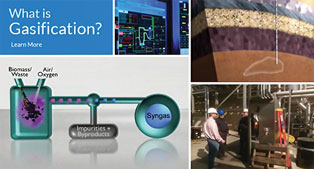 |
The Gasification and Syngas Technologies Council, formerly known as the Gasification Technologies Council, will now encompass the syngas production, processing and conversion industries.
Those eligible for GSTC membership include technology, equipment and service providers, as well as plant owners and operators in the energy, power, chemical, fertilizer, refining, fuel and waste management industries. GSTC is a global organization, with members from across the Americas, Europe and Asia.
GSTC promotes the role that gasification and syngas technologies play in helping improve the energy, power, chemical, refining, fuel and waste management industries. GSTC encourages the use of economically competitive and environmentally conscious technologies to produce electricity, fuels, chemicals, fertilizers, substitute natural gas and hydrogen from a variety of feedstocks, including coal, petroleum coke, natural gas, refinery liquids, biomass and waste.
GSTC also facilitates relationships among technology, equipment and service providers, as well as plant owners and operators.
Cargo delivered to Petronet LNG
 |
The inaugural LNG cargo was delivered to Petronet LNG Ltd. under a new sales and purchase agreement (SPA) signed on December 31, 2015 between Petronet and Ras Laffan Liquefied Natural Gas Co. Ltd. The LNG cargo was delivered to Dahej LNG terminal in India on January 13, 2016, marking the commencement of the new 1-MMtpy SPA.
The new SPA, together with the long-term SPA between Petronet and RasGas that was signed in 1999 for 7.5 MMtpy, raises the total annual long-term commitment between the two companies to 8.5 MMtpy. RasGas has been supplying LNG reliably to India and Petronet, a key long-term partner and customer of RasGas, since 2004.
The LNG cargo, which was loaded aboard the Al Thumama vessel at Ras Laffan on January 8, 2016, was successfully discharged at Dahej LNG terminal on January 13, 2016. To date, RasGas has delivered nearly 81 MMtpy of LNG to India to help meet the country's growing demand for cleaner fuel and energy.
Cryo technology for Russian gas project
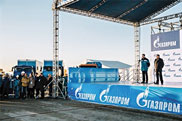 |
The Linde Group was selected by Gazprom, Gazprom Pererabotka Blagoveshchensk and its general contractor, NIPIgas, as licenser for cryogenic gas separation technology at the Amur gas processing plant (Amur GPP) in Russia's Far East region. Linde will engineer and supply units for ethane and NGL extraction; nitrogen rejection; and helium purification, liquefaction and storage. This is part of Gazprom's project to supply Russian gas to China via the Power of Siberia pipeline from eastern Siberian gas fields in five phases ending in 2024.
In late December 2015, Linde and NIPIgas entered into a binding engineering and supply contract for these units for all five construction phases of the Amur GPP. Phase 1 will consist of two ethane and NGL (propane, butane, pentane, hexane) extraction and nitrogen-rejection units, and one helium production unit. Related engineering works are in progress. When completed, the Amur GPP will be one of the largest gas processing plants in the world, with a capacity of up to 49 Bcmy of natural gas.
The cooperation agreement covers process technologies, engineering and services related to the treatment and liquefaction of natural gas, as well as to the localization of the respective equipment production in Russia.
Velocys announces GTL plant progress
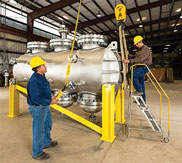 |
EPC contractor Ventech Engineers has the final major contract for the installation of process modules, related piping and ancillary equipment for ENVIA Energy's Oklahoma City GTL plant, to be located adjacent to Waste Management's East Oak landfill site. ENVIA Energy is a JV of a subsidiary of Waste Management Inc., Ventech Engineers International and Velocys. The JV was formed to produce renewable fuels and chemicals from biogas and natural gas using the GTL process.
Velocys made available to ENVIA Energy a $3-MM equity contribution and a $9-MM loan secured on the project. The loan terms provide Velocys with the opportunity to gain a greater equity share of the project, and greater influence in commissioning, startup and plant operations.
Fabrication of the modular process units is essentially complete by Ventech Engineers at its Pasadena, Texas facility. In 2015, the project completed manufacture of Velocys' full-scale reactors and the initial catalyst charge for the plant. Mechanical completion of the GTL plant is expected in mid-year 2016.
Single-train dehydrogenation unit for China
Clariant, a leader in specialty chemicals, has been awarded a contract by Hengli Petrochemical (Dalian) Refinery Co. Ltd. to develop an extensive propane and butane dehydrogenation unit in cooperation with CB&I. The project includes license and engineering design of the coprocessing unit to be built in Dalian, Liaoning Province, China.
The design is based on CB&I's Catofin catalytic dehydrogenation technology using Clariant's tailored Catofin catalyst and Heat Generating Material (HGM). The unit will process feedstock containing 300 metric Mtpy of propane and 600 metric Mtpy of isobutane for the joint production of propylene and isobutylene. When completed, it will be the world's largest single-train coprocessing dehydrogenation unit in the world.
The Catofin process operates at optimum reactor conditions to maximize conversion of propane and isobutene for a high yield of propylene and isobutylene, and correspondingly low investment and operating costs. These performance advantages are enhanced through the inclusion of HGM in the Catofin process.
HGM is a metal oxide material designed to significantly increase selectivity and yield of Catofin units. The material is loaded into the catalyst bed with the catalyst, where it undergoes oxidation and reduction during the operating cycle, producing heat and driving the dehydrogenation reaction. This boosts yields and saves energy, and also reduces emissions.
Hengli will be the second coprocessing plant to use HGM, following the successful unit designed for Shandong Sincier Petrochemical Co. Ltd. in Dongying, Shandong Province, China.
Modular LPG plant automation in Vietnam
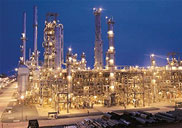 |
Honeywell will supply a 250-MMscfd modular gas processing plant and advanced automation systems to PetroVietnam subsidiary PV Gas. The plant will use Honeywell UOP's modular gas processing plant to separate LPG from natural gas at its Ca Mau facility near the southern tip of Vietnam.
Honeywell Process Solutions will serve as the integrated main automation contractor and supply the integrated controls and safety systems for the facility and terminal. PV Gas' total capital investment for the project is approximately $498 MM. PV Gas supplies natural gas to generate nearly 40% of Vietnam's electricity, and local production accounts for more than 55% of Vietnam's domestic demand for LPG.
The Honeywell UOP modular plant will separate LPG, a propane and butane mix, from natural gas, to be used as compressed fuel for heating and transportation and to manufacture plastics and synthetic rubber. Globally, LPG consumption is growing rapidly due to its versatility, low carbon emissions and energy efficiency. Within Asia, LPG demand is expected to grow at about 8.5%/yr through 2020, according to IHS.
As the integrated main automation contractor, Honeywell will provide the front-end engineering and design (FEED) to design, deliver and install automation, instrumentation, controls, safety and security for the gas processing units and for the terminal operations. This unified approach will be critical to help the project start up quickly and to meet operational and business readiness goals.
UOP provides the processes that make the facility work, and HPS automation controls will keep it running efficiently and safely. PV Gas will see lifecycle benefits from this approach, beginning with fast installation and startup and sustained through training and site services.
Heater completed for Yamal LNG
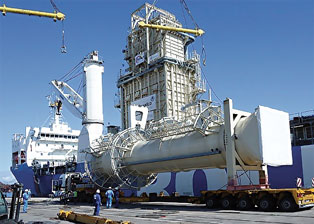 |
UK-based EPC and maintenance company Unit Birwelco has completed construction of a complex, multimillion-pound project for a preassembled fired heater package to Russia's Yamal LNG project. Fabricated in northern Spain and shipped 3,000 mi via the Arctic Northern Sea Route, the 900-t, skid-mounted, 85-MW fired heater package will supply essential heating to the client's process plant and offices on the northeast of the Yamal Peninsula.
The project schedule was 16 months, but because the Arctic Northern Sea Route remains open to shipping only part of the year, timely completion of the project was essential.
Harsh local weather conditions demanded that the equipment be installed 2 m above ground level on a purpose-designed support grillage, to ensure that plant operator access areas were kept above winter snow and pack ice levels. All package documentation needed to be translated and fully certified to meet stringent Russian technical passport requirements.
Unit Birwelco General Manager, Carl Blewer, noted that the scale of the heater package, the requirement for the maximum possible extent of preassembly, and the specialist metallurgical considerations imposed by extreme Siberian winter temperatures combined to make it a demanding project. The engineered equipment needed to smoothly operate in Arctic conditions, with a design temperature of –50°C. All structural elements, heater pressure parts, and piping materials were made from low-temperature carbon steel, while instrumentation and electrical items were winterized with trace heating and insulation, or placed within heated enclosures.
The project scope included design, fabrication and preassembly of the modularized dual-fuel gas fired heater, which stands at more than 50 m tall, weighs 900 metric t and will deliver in excess of 85 MW of heat duty.
Chevron produces first LNG at Gorgon
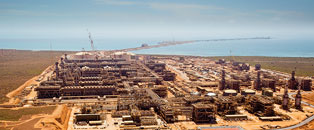 |
Chevron Corporation has started producing liquefied natural gas (LNG) and condensate at the Gorgon Project on Barrow Island off the northwest coast of Western Australia. The first LNG cargo is expected to be shipped in mid-March. The corporation expects that legacy assets, such as Gorgon, will drive long-term growth and create shareholder value for decades to come. The long-term fundamentals for LNG are attractive, particularly in the Asia-Pacific region, and this achievement is a significant milestone for all involved.
Congratulations are due to the Gorgon workforce on this achievement, the result of collaboration with hundreds of suppliers and contractors, and many tens of thousands of people across the world during the project design and construction phases.
Chevron is positioned to become a major LNG supplier by 2020. In particular, Chevron’s Australian projects are well located to meet growing demand for energy in the Asia-Pacific region, and more than 80% of Chevron’s Australian subsidiaries’ equity LNG from the Gorgon and Wheatstone projects is covered by sales and purchase agreements and heads of agreements with customers in the region.
The Gorgon project is supplied from the Gorgon and Jansz-Io gas fields, located within the Greater Gorgon area, between 80 mi and 136 mi off the northwest coast of Western Australia. It includes a 15.6-MMtpy LNG plant on Barrow Island, a carbon dioxide injection project, and a domestic gas plant with the capacity to supply 300 terajoules of gas per day to Western Australia. The Chevron-operated Gorgon project is a JV between the Australian subsidiaries of Chevron (47.3 %), ExxonMobil (25 %), Shell (25 %), Osaka Gas (1.25 %), Tokyo Gas (1 percent) and Chubu Electric Power (0.417 percent).
World-scale methanol plant in Louisiana
G2X Energy, a developer of advanced natural gas-to-methanol projects, along with strategic partner Proman Group, have entered into an engineering services contract with Toyo Engineering Corp. for the detailed engineering needs on their previously announced world-scale methanol production facility located in Lake Charles, Louisiana.
Toyo will provide basic engineering for offsite and utility facilities and detailed engineering of the complete methanol facility.
G2X Energy also entered into license and engineering contracts with Johnson Matthey for technology licensing, basic engineering, catalyst and technical services for the project.
Construction on the Big Lake Fuels plant will take approximately three years to complete and will add 2,500 direct and indirect jobs to the Lake Charles area.
Once complete, the G2X facility, known as Big Lake Fuels Methanol Plant, will produce
1.4 metric MMtpy of commercial-grade methanol. GP




Comments